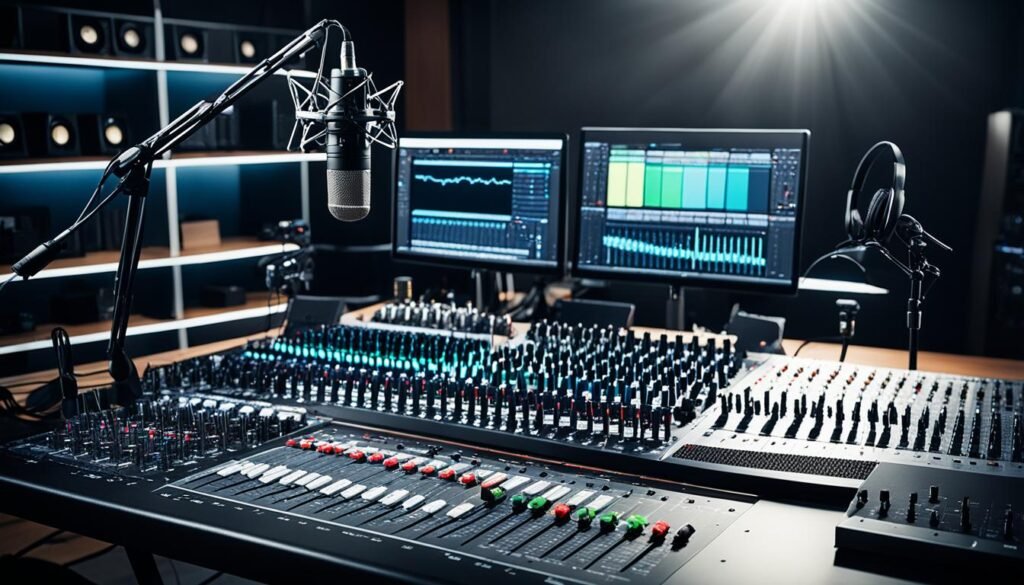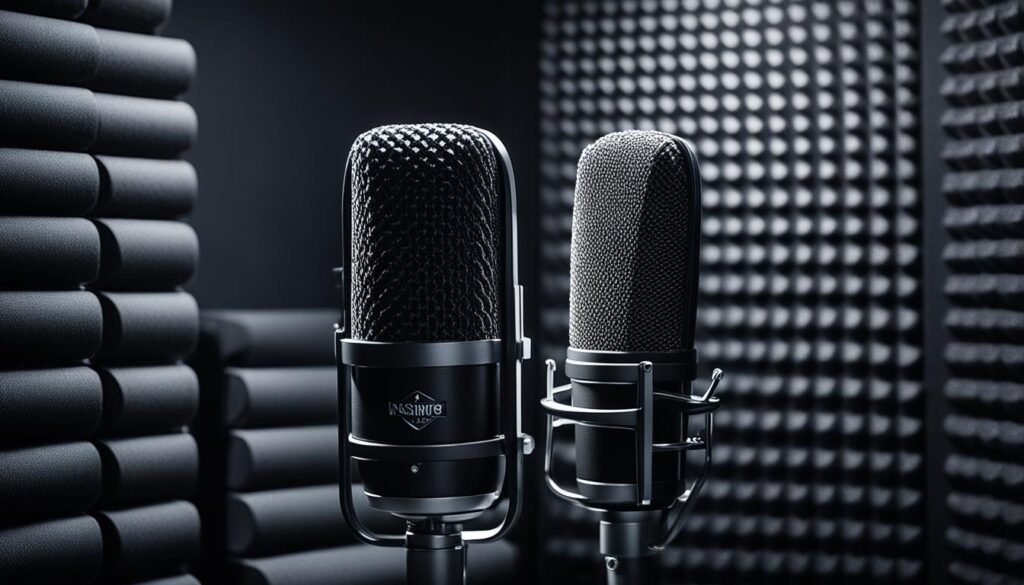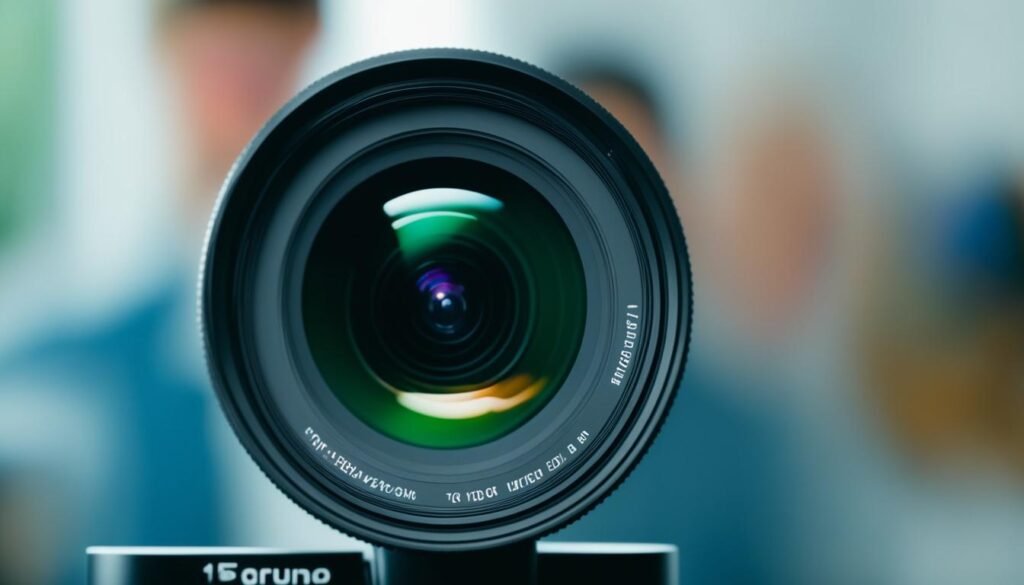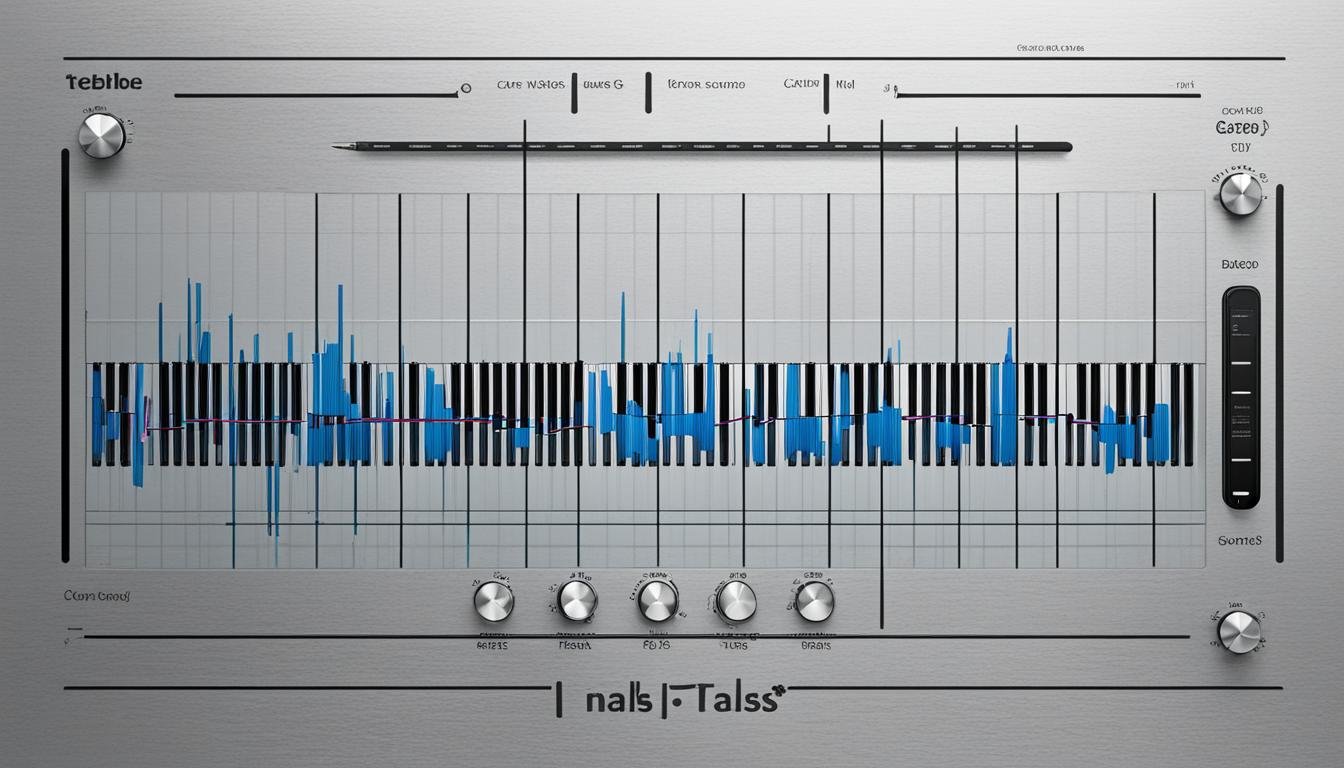In the digital age, visual content is key. Yet, great audio also shines. Quality audio draws in listeners and creates a deep experience. But what makes audio “high-quality,” and how do creators make sure their content is top-notch? Let’s look into the secrets of crafting standout audio content.
Key Takeaways
- Audio quality is a crucial factor in engaging your audience and establishing brand credibility.
- Intelligibility and optimal audio levels are essential for creating high-quality audio content.
- Choosing the right recording environment and equipment is key to capturing professional-grade audio.
- Post-production techniques, such as equalization and normalization, can enhance the overall audio quality.
- Consistent audio quality and adherence to professional standards are vital for maintaining a polished, engaging audio experience.
What’s the difference between average and outstanding audio? How do you make sure your work is exceptional and captures attention?
Importance of Audio Quality in Content Creation
When making videos, good audio is key. It helps viewers understand better and adds value to what they see. High-quality audio content let’s listeners hear each word clearly. This makes a video more appealing and holds viewer attention.
Impact on Audience Engagement
Clear audio is vital. It makes videos more enjoyable and helps people focus. Good audio quality improves how an audience connects with your content. But, if the sound is bad, viewers might lose interest quickly.
Role in Establishing Brand Credibility
Quality audio content keeps people interested and grows trust in your brand. Perfectly balanced sound and no background noise shows professionalism. It makes your brand seem dependable and reputable.
Defining High-Quality Audio Content
Creating engaging content requires top-notch audio. High-quality audio content means sound that is clear, easy to understand, and grabs your attention. It makes the audience’s experience better.
Criteria for Intelligibility
Audio intelligibility is crucial. It means how clearly people can hear and understand the words. The better the intelligibility, the more your audience will enjoy and learn from what they hear.
Optimal Audio Levels
Aim for specific audio levels to get the best sound. Shoot for -12 dBFS on average, with the highest point at -6 dBFS and the lowest at -24 dBFS. These settings help ensure your audio is both clear and of high quality.
Focus on making your audio clear and keeping it at the right levels. This way, you’ll offer a top-notch listening experience. Your audience will stay interested and your content’s value will shine.
Choosing the Right Recording Environment
For top-notch audio, the recording environment is key. To make sounds clearer, you should cut out noise. You can do this in two ways. First, record in a sound-proof room. Second, get rid of noise sources like fans, ACs, or pets.
Noise Suppression Techniques
In post-production work, you can take more steps to remove noise. Use tools in your editing software. These can be filters or smart algorithms. They help get rid of unwanted sounds, making your audio neat and tidy.
Soundproofing Strategies
Aside from cutting out noise, soundproofing is important too. This greatly boosts your audio’s quality. Ways to soundproof include putting up special panels and using materials that absorb sound. These steps create a space where noise can’t easily get in or out.
Choosing the best area to record and using smart noise-cutting and soundproofing methods can really lift your work. You’ll get better audio quality and more defined sounds. This makes the experience richer for everyone who listens.
Audio Equipment Essentials
Making high-quality audio content needs the right tools. The microphone and extras chosen greatly affect the sound’s final quality. Knowing the different microphone types and how they work helps creators pick the best audio gear for what they do.
Microphone Types and Applications
Microphones vary in style and purpose. For example, condenser microphones pick up sound with great detail, perfect for voices and acoustic music. Whereas, dynamic microphones handle loud sounds better, making them great for live music and amplified instruments.
Choosing a microphone depends on where you’ll record, what you’re recording, and your sound goals. Experts at Classroom Services at the University of Pittsburgh can offer advice. They help pick the best microphone types for each situation. This ensures your audio captures exactly the sound you want.
Mixers and Supplementary Gear
Microphones are just the beginning. Using mixers and other extras can level up your audio. Mixers blend sounds from different sources for a smooth, even mix.
With many pieces of audio gear, setting up correctly is key. Tips from the team at Classroom Services or Academic Digital Media are vital. They can guide through complex setups. This helps creators reach their goal of making top-notch audio.

Recording Software and Settings
The software for audio recording and its settings play a big part in the audio’s quality. Panopto, a video recording tool, uses a colored meter to guide users. It helps keep the audio level in the green but near the yellow. This ensures a good quality throughout the recording.
Panopto for Audio Recording
Panopto comes with its own audio recording tools. It’s easy to use and has real-time monitoring. This means users can keep track and adjust their audio levels as they record. The result is a clear and sharp sound.
Adobe Audition for Professional Audio Editing
When it comes to editing audio, Adobe Audition is top-notch. It has advanced tools for things like equalization and normalization. These help make the audio sound better. The aim is to get a finished audio that’s as good as a professional studio’s work.
Knowing how to use different recording software and tweaking the right settings is key. It ensures the best sound from the start to finish of your recording. This makes sure your listeners enjoy the audio.
Effective Microphone Techniques
Mastering how to use a microphone well is key to making clear, balanced audio. By focusing on where the microphone is, how far it is from you, and watching how you speak and handle the volume, you can make your audio better.
Positioning and Distance
For the best sound, put the microphone 3 to 5 inches from your mouth. It should point slightly downwards. This stops the hard “p” and “t” sounds and the hissing “s” sounds. Keeping the mic at the right distance and angle makes the recording clear and natural.
Enunciation and Volume Control
When you speak, make sure people understand every word clearly. Don’t mumble. Talk like you’re telling a story to friends, loud and clear. Consistent loudness in your voice makes a big difference in how good your recording sounds.
Using these tips, anyone can make their audio sound better. This helps your listeners enjoy what they hear more.
Audio Post-Production Enhancements
Post-production software helps make audio better. It fixes issues in the sound. Two main ways it does this are through equalization and normalization.
Equalization for Frequency Optimization
Equalization, or EQ, makes audio clearer. It boosts good frequencies and cuts bad ones in a sound. This makes the sound easier to understand. With EQ, a dull recording turns into a sharp, professional one.
Normalization for Volume Adjustment
Another key step is normalization. It makes audio louder by picking a top level. This way, it’s not too quiet or distorted. So, listeners get a steady, clear sound.
Adopting equalization and normalization helps a lot. Popular tools for this are Adobe Audition and Premiere Pro. They help creators make their audio better. With these tools, they can produce top-quality work.
high-quality audio content
Creating top-notch audio content needs a steady hand. To keep the sound top-shelf, make sure your levels are just right. Then, add some magic with equalization and normalization. Don’t forget where you put the mic or how clearly you speak.
Ensuring Consistent Audio Quality
Great audio means a great experience for listeners. It builds trust in your work and makes you stand out. It’s key to keep every bit of your audio at a high standard. This makes your work sound polished and professional every time.
Maintaining Professional Standards
If you want your audio to hit the spot, stick to the pros’ rules. Perfect your levels, polish the sound, and use mics the right way. Following these steps makes sure your content is flawless. It boosts your brand’s image and puts you at the front of the pack.

Lighting and Visual Considerations
Lighting is vital when making top-notch video content with good sound. Make sure not to have the speaker in front of a bright light source like a window or a lamp. This setup can put the speaker in the dark and make it hard for viewers to see their face properly. It’s best if the light is coming from the direction of the camera or a little bit from the side. This setup ensures the best lighting for video quality.
Also, think about what’s in the background and what the speaker is wearing. This helps avoid distractions and keeps everything looking professional. Addressing these lighting and visual aspects can boost how polished your video looks. It will make your content more interesting and enjoyable for people watching.
Video Framing and Composition
Good video not only sounds great but also looks amazing. How you frame and compose the video is key. It makes the audience really get into what they’re watching.
Rule of Thirds
The rule of thirds splits the frame into nine parts. You line up the subject on these points. This trick helps make the video look just right, pulling the viewer towards what matters most.
Subject Placement
Choosing where to put the main subject in your shot is important. It can make the video more engaging. By using the rule of thirds and picking the right spot for your subject, you invite the audience to really explore your content.

Engaging Visuals and Graphics
Using engaging visuals and graphics greatly enhances videos. It includes cool titles and transitions. These things grab the viewer’s attention. Visual storytelling techniques also play a big part in keeping the audience interested.
Titles and Transitions
Great titles introduce new sections and emphasize important points. They get the viewer ready for what’s next. Transitions between scenes smooth things out, making the video fun to watch.
Visual Storytelling Techniques
Putting graphics and images in the right places can make your video shine. They highlight key info, show feelings, and add depth to what’s being said. These visuals make the story more engaging.
With a mix of engaging visuals and graphics, you can make videos grab people’s attention. This way, creators can really connect with the viewers, making their video stand out.
Professional Video Editing Software
Professional video editing software like Adobe Premiere Pro has many advanced features. These let content creators make videos that are very polished. They make videos beautiful to look at and great to listen to. Editors can use these tools to make their videos look professional. This helps keep the audience interested and involved.
| Feature | Description |
|---|---|
| Audio Editing | With these tools, you can edit audio in many ways. You can make it sound better and clearer. This is important for making your videos more enjoyable. |
| Visual Enhancements | You can also make your videos look really cool. There are lots of effects and colors to choose from. This makes your videos stand out and look amazing. |
| Collaboration and Workflow | Some video editing software lets you work with others easily. It helps everyone work smoothly together. This makes the final video come out great. |
Professional video editing software helps content creators a lot. They can make their videos better. Viewers enjoy watching these high-quality videos more.

Creating Value for the Audience
It’s key to make sure the video content offers value to its viewers, no matter the type. This means either solving their problems, adding useful information, or simply entertaining them. Videos can teach something or just be fun to watch. By doing this, the video becomes more important and memorable to those watching.
Solving Problems or Addressing Challenges
One good way is by looking at what issues the audience has and trying to solve them. This might mean showing how-to steps, giving practical advice, or sharing experts’ views. By helping the audience with their challenges, the video gains a lot of relevance and value. It also makes the creators someone the viewers trust to give good advice.
Providing Useful Information or Entertainment
Video content can also aim to teach viewers something new or help them get better at something they’re interested in. This could be through lessons, insights from a certain field, or clear guides. Alternatively, the video content could just aim to entertain the audience. This is often done by sharing stories, using cool visuals, or presenting new and interesting perspectives. A good video often balances teaching and entertaining well. This mix is what makes viewers keep watching and coming back for more.
Promoting and Distributing Audio Content
After creating top-notch audio content, it’s vital to get it out there. A good promotion strategy is key. This way, creators can draw a lot of attention to their content.
Search Engine Optimization (SEO)
One essential step is making the audio content easy to find on search engines. This is done by using the right keywords and crafting detailed descriptions and tags. Such steps help the content rise in search results, making it easier for people looking for similar audio to find it.
Social Media and Email Marketing
Using social media and focused email marketing pushes audio content further. Sharing exciting parts or full episodes on social media helps create a strong bond with listeners. This makes them feel part of a more personal, interactive experience. Additionally, sending content through personalized emails keeps your listeners updated directly, encouraging stronger ties.
Combining SEO, social media, and email marketing is a comprehensive way to promote audio content. This can lead to higher recognition, accessibility, and appreciation among the desired audience.
Conclusion
Creating top-notch audio content needs a blend of technical, creative, and strategic skills. Focus on making speech clear, use the best recording gear, and perfect your editing. Also, don’t forget to add visuals to enhance your work.
By planning well, executing with skill, and promoting wisely, your audio work can shine in a competitive online world. Your efforts must ensure the final product is of high quality yet connects deeply with listeners.
Wrapping up your content well is key. It lets you highlight the most important parts, remind the audience why it’s valuable, and motivate them to respond. A strong ending ensures your work is remembered and valued online.
